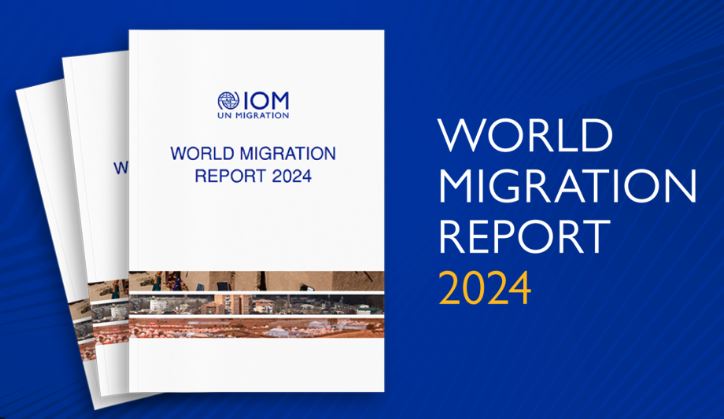World Migration Report 2024
The World Migration Report 2024, released by the International Organization for Migration (IOM) underscores that while migration remains an integral part of the solution for many economies, societies, and families worldwide, significant challenges persist in the rapidly changing global context.
Migration and Displacement Shaped by Intensifying Global Transformations
The report highlights how the impacts of geopolitical, environmental, and technological transformations have intensified in the last two years. Hardening geopolitics, evidenced by conflicts such as the Russian invasion of Ukraine and the conflict in Gaza, have led to profound consequences for global migration and displacement.
Ecologically negative human activities continue to exacerbate climate change, with potentially severe implications for human mobility. Advances in artificial intelligence are also reshaping various aspects of life, including migration systems, risking the exacerbation of digital divides between and within countries.
Key Migration Data at a Glance
The report provides an overview of key migration statistics:
- 281 million international migrants globally in 2020 (3.6% of the world’s population)
- 169 million migrant workers globally in 2019
- Around 8,500 migrants reported dead or missing globally in 2023
- USD 831 billion in international remittances globally in 2022
- 117 million people living in displacement globally at the end of 2022
Migration as Part of the Solution, Despite Challenges
Despite the politicization of migration narratives in some parts of the world, the report emphasizes that migration has long served millions of people well, providing opportunities and enriching lives. Most international migration remains safe, orderly, and regular, and acts as a driver of human development, generating significant benefits for migrants, their families, and countries of origin. However, humanitarian crises due to displacement remain a major challenge, with forced displacement at its highest on record in the modern era, further exacerbated by environmental impacts and climate change.
Migration and Climate Change
The report highlights that climate change is expected to force 216 million people across six continents to move within their countries by 2050. While climate change is not the sole driver of migration, it exacerbates existing pressures on communities and systems, leading to increased displacement.
No Continent Left Unaffected
The report profiles both the Global South and the Global North, demonstrating that no region of the planet is immune to the impacts of climate change and the consequent migration of people. In North Africa, significant warming and decreased rainfall have led to displacements triggered by droughts and wildfires in countries like Libya, Algeria, and Morocco. The Sahel region has experienced a 20% decrease in rainfall since the 1970s, making it prone to droughts, while parts of West and Central Africa have seen millions displaced due to sudden-onset disasters.
In East and Southern Africa, climate change-linked disasters such as droughts and cyclones have become more frequent and intense. Cyclone Freddy alone displaced over 500,000 people in Malawi in early 2023.
Asia, the Americas, Caribbean, and Oceania Face Challenges
In Asia, the Indian subcontinent has witnessed significant climate-related displacement, with the 2022 floods in Pakistan resulting in nearly 1,700 deaths and more than 8 million displacements. Bangladesh, a low-lying country, records thousands of displacements every year due to disasters. Central Asia faces issues such as increasing desertification, glacial melt, and dam failures, leading to floods and displacement.
The Americas, Caribbean, and Oceania also face daunting challenges. South American countries like Ecuador and Peru are seeing environmental factors enhance both internal and international migration. The Caribbean islands are some of the most at-risk from the impacts of climate change, with hurricanes causing significant displacements.
Even the Global North is not unaffected, with Canada and the United States experiencing wildfires and hurricanes that have led to hundreds of thousands of displacements.
India in the Report
India plays a significant role in global migration patterns. The report notes the strong influence of climate impacts on internal migration from Rajasthan, Uttar Pradesh, and Madhya Pradesh within India.
Moreover, India is home to the world’s largest number of international migrants, with 18 million Indians residing in countries such as the United Arab Emirates, the United States, and Saudi Arabia. In 2022, India maintained its position as the top remittance destination, receiving over USD 111 billion, making it the first country to surpass the USD 100 billion threshold.
About International Organization for Migration
The International Organization for Migration has undergone several transformations since its establishment in 1951 as the Provisional Intergovernmental Committee for the Movement of Migrants from Europe (PICMME) in the aftermath of World War II.
The organization’s name changed several times, reflecting its development into a global migration agency. In 2016, IOM entered into an agreement with the United Nations, becoming a related organization. Currently, IOM has 175 Member States and 8 states with Observer status, with India joining as a Member State on June 18, 2008. The organization’s headquarters is located in Geneva, Switzerland.
Month: Current Affairs - May, 2024
Category: Reports & Indexes Current Affairs








